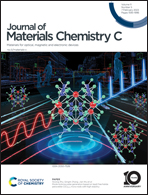Novel copper borate ceramics with lithium-based sintering aids for LTCC terahertz applications†
Abstract
Novel CuB2O4–Cu3B2O6 substrates doped with three Li-based sintering aids, Li2WO4, LiBO2 and Li2CO3, were prepared using the LTCC (low temperature cofired ceramic) technology. The main goals of the work were to confirm the feasibility of LTCC substrates based on the developed materials and to prove their good dielectric properties in a broad terahertz frequency range. The comprehensive characterization of the thermal, compositional, microstructural, and dielectric properties of the fabricated ceramics was carried out by hot-stage microscopy, thermal analysis, dilatometry, X-ray diffractometry, optical microscopy, scanning electron microscopy, energy dispersive spectroscopy, and time domain spectroscopy. The ceramic powders were used for the preparation of slurries and tape casting of proprietary green tapes. Test LTCC multilayer structures with embedded conductors were fabricated. The developed ceramics doped with Li2WO4 and LiBO2 seem to be very good candidates for LTCC substrates in THz applications. These substrates demonstrate a low sintering temperature 860–880 °C, a low dielectric permittivity 5.4–5.7 and a low loss tangent 0.008–0.01 at 1 THz, as well as a low thermal expansion coefficient of 5.7 ppm °C−1, quite well fitted to silicon, and a high flexural strength.



 Please wait while we load your content...
Please wait while we load your content...